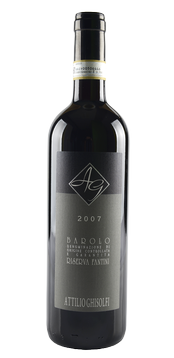Attilio Ghisolfi, Barolo Riserva (Piedmont, Italy) “Fantini” 2007 (Quintessential LLC, $119): Such are the riches of the Barolo wine zone that even those of us who visit the area regularly can be delighted by the discovery of a producer with whom we are not already familiar.
I discovered Attilio Ghisolfi’s Barolos thanks to Kerin O’Keefe’s comments in her new book, “Barolo and Barbaresco” (University of California Press). This winery had not been anywhere on my personal  list of top Barolo producers, but in that, I apparently was not alone: O’Keefe describes Attilio Ghisolfi as “Yet another of Monforte d’Alba’s little-known treasures that flies under the radar of the media…”. Tasting the three Ghisolfi Barolo wines that are currently available in the U.S., I found much to like.
list of top Barolo producers, but in that, I apparently was not alone: O’Keefe describes Attilio Ghisolfi as “Yet another of Monforte d’Alba’s little-known treasures that flies under the radar of the media…”. Tasting the three Ghisolfi Barolo wines that are currently available in the U.S., I found much to like.
Attilio Ghisolfi is what I would categorize as a traditional-style Barolo producer. The wines do not express the richness, fleshiness and international appeal that derive from the marriage of new oak and very ripe fruit. Instead, they are lean and edgy, with flavors that are precise and pure. Ironically, Ghisolfi attains this style using some new-school methods such as rotary fermenting vats, which enable a shorter tannin-extraction period and result in softer tannins. On the other hand, he employs the low-tech practice of fermenting his wines with ambient yeasts rather than inoculating the juice with commercial yeast strains, and he ages his wines in both Slavonian and French oak containers that range in size from 60 gallons to about 800 gallons.
Ghisolfi’s Barolos come from the Bussia cru in Monforte d’Alba, specifically the Visette section, which sits at more than 1100 feet altitude. One of the three Ghisolfi Barolos currently available in the U.S. is the 2007 Barolo Bussia ($60), from the youngest vines; the other two derive from older vines and more specific parcels: The 2009 Bricco Visette Bussia Barolo ($80) and the 2007 Barolo Riserva Fantini, from a single vineyard within Visette. All of the grapes for the Fantini come from vines that are more than 40 years old; furthermore, as O’Keefe reports in her book, these vines are the Rosé sub-variety of Nebbiolo, which is extremely unusual in the Barolo area these days, a variety that contributes amazing finesse to its wines.
The 2007 Barolo Riserva Fantini surprised me because many Barolo wines from the warm, dry 2007 vintage are rather too rich and fleshy for my taste. While this wine shows lots of ripeness in its fruit expression, it also has sufficient acidity to give definition and delineation in the mouth, and fine, crystalline tannins to balance the fruit. Aromas and flavors in this wine are classic for Barolo: vivid cherry and black berry fruit, a floral note, and gentle smokiness, along with tar, leather and spice.
The less expensive 2007 Bussia is likewise pleasantly fresh and edgy for its vintage. The 2009 Bricco Visette Bussia, from what some would consider a lesser vintage, exudes freshness and vibrancy, and slightly more focus than the 2007 Bussia, and will improve with five-plus years of aging. The 2007 Fantini is the most youthful of all. Nothing about it begs for cellaring rather than drinking — it is gorgeous now — but experience says that a Barolo such as this is still gaining momentum and that its complexity in time will be even more impressive than now.
92 Points
